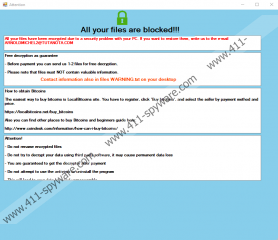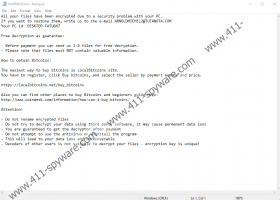Somik1 Ransomware Removal Guide
Every time you download a new file or open a strange spam email, you need to think of Somik1 Ransomware. There are thousands of infections just like it too, so you need to think about them as well, but in this report, we are talking about Somik1. The name of this malware comes from the executable file named “somik1.exe.” This could be the name of the launcher in your case, but the name could also be entirely different and random too. Another file that we need to mention is “xxx_media_player.exe.” The threat is coded to avoid this file during the encryption, and so it is possible that a fake media player could be used to distribute the threat. The last file ignored by the threat is “HELLO.txt,” which could be the ransom note file. In our case, however, the ransom note file was named “WARNING{number}.txt.” All of these components require removal, of course. Unfortunately, even if you successfully delete Somik1 Ransomware, your files will stay encrypted and, therefore, unreadable.
We do not know how Somik1 Ransomware slithered into your personal computer, but if you have an idea as to how that might have happened, you probably know exactly where the infection lies. It is unlikely that you would realize that this is a dangerous threat right away, but if you did that, you could potentially remove the threat before your personal files were encrypted. Unfortunately, the threat can encrypt pretty much every single personal file. It does not affect system files, but unique files created on the computer are bound to be corrupted. To help you identify these lost files, the “.arnoldmichel2@tutanota.com” is added as an additional extension. Luckily, the name is not changed, so you can assess the damage. For example, a file named “document.pdf” is turned into “document.pdf.arnoldmichel2@tutanota.com.” Can you salvage your files by removing the added the extension? If only things were that easy. In fact, at the time of research, there was no way of restoring the files, so even the complete removal of the threat did not help.
When Somik1 Ransomware encrypts files, it also drops a file named WARNING{number}.txt right onto the Desktop. In fact, several copies could be placed. The message inside this file pushes to send one or two corrupted files to ARNOLDMICHEL2@TUTANOTA.COM. The sent files might be restored, but do not trust the attackers’ promises to decrypt all files. They promise you that only so that they could trick you into paying a huge ransom. A window entitled “Attention” pushes you to do the same. If you have not closed this file, it is possible that you could open the Task Manager to find a malicious process. This process could lead you to the launcher of the threat. All in all, even if you realize that trusting cybercriminals is a bad idea, you might still consider the option of following their instructions if you have no other way of recovering the files. What about backups? If they exist outside the infected computer, you are good. If you have decided to contact the attackers and pay the ransom, remember that you are unlikely to get anything in return for your hard-earned money.
If the “Attention” window is still on your screen, launch the Task Manager, identify the malicious process, and find the malicious .exe file using it (right-click it and select ‘Open file location’). That being said, you do not need to rip your hair out of your head trying to remove Somik1 Ransomware manually. After all, the removal of this threat is not the only thing you need to worry about. It might be even more important to secure your system to ensure that malicious threats cannot invade it again. Do you know how to delete existing threats and also ensure protection against those that could try to attack you next? You can do that by implementing a trusted anti-malware program. It will simultaneously secure your system and also delete Somik1 Ransomware from your computer. Hopefully, you have backups and can replace the encrypted files afterward, but if that is not an option, learn from your mistakes.
How to delete Somik1 Ransomware
- Delete all ransom note files named WARNING{number}.txt from the Desktop.
- Find the launcher .exe file of the infection, right-click and Delete it.
- Empty Recycle Bin and then instantly perform a system scan using a legitimate malware scanner.
Somik1 Ransomware Screenshots:



